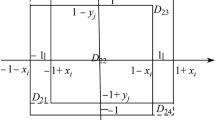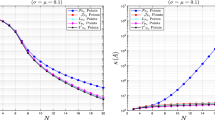Abstract
This paper investigates the numerical approximation of the tempered fractional integral by using the Sinc-collocation scheme. The algorithm is extended to solve a class of tempered fractional differential equations that converges to the solution with exponential rate. Several numerical examples compare the numerical approximations with the exact solutions. The behavioral responses of the lumped capacitance model with tempered fractional order for transient conduction are investigated. The efficiency and accuracy of the proposed scheme are analyzed in the perspective of the \(L_2\)-norm error and convergence order



Similar content being viewed by others
References
Babaei A (2017) On analytical approximate solution of the fractional type Rosenau–Hyman equation. Fundam Inf 151(1–4):135–143. https://doi.org/10.3233/fi-2017-1483
Baleanu D, Guvenc ZB, Machado JAT (eds) (2010) New trends in nanotechnology and fractional calculus applications. Springer, New York. https://doi.org/10.1007/978-90-481-3293-5
Baumann G, Stenger F (2011) Fractional calculus and Sinc methods. Fract Calc Appl Anal 14(4):568–622. https://doi.org/10.2478/s13540-011-0035-3
Baumann G, Stenger F (2015) Sinc-approximations of fractional operators: a computing approach. Mathematics 3(2):444–480. https://doi.org/10.3390/math3020444
Bhrawy AH, Zaky MA (2014) Numerical simulation for two-dimensional variable-order fractional nonlinear cable equation. Nonlinear Dyn 80(1–2):101–116. https://doi.org/10.1007/s11071-014-1854-7
Bhrawy AH, Ezz-Eldien SS, Doha EH, Abdelkawy MA, Baleanu D (2017) Solving fractional optimal control problems within a Chebyshev–Legendre operational technique. Int J Control 90(6):1230–1244. https://doi.org/10.1080/00207179.2016.1278267
Buschman RG (1972) Decomposition of an integral operator by use of Mikusiński calculus. SIAM J Math Anal 3(1):83–85. https://doi.org/10.1137/0503010
Dabiri A, Butcher EA (2017) Efficient modified Chebyshev differentiation matrices for fractional differential equations. Commun Nonlinear Sci Numer Simul 50(ISSN 1007–5704):284–310
Dabiri A, Butcher EA, Nazari M (2017) Coefficient of restitution in fractional viscoelastic compliant impacts using fractional Chebyshev collocation. J Sound Vib 388:230–244. https://doi.org/10.1016/j.jsv.2016.10.013
Dabiri A, Butcher EA (2017) Stable fractional Chebyshev differentiation matrix for numerical solution of fractional differential equations. Nonlinear Dyn. https://doi.org/10.1007/s11071-017-3654-3
Dabiri A, Nazari M, Butcher EA (2016) Optimal fractional state feedback control for linear fractional periodic time-delayed systems. In: 2016 American control conference (ACC), IEEE. https://doi.org/10.1109/acc.2016.7525339
Dabiri A, Nazari M, Butcher EA (2016) Optimal fractional state feedback control for linear fractional periodic time-delayed systems. In: American control conference (ACC). https://doi.org/10.1109/acc.2016.7525339
Deng J, Zhao L, Wu Y (2016) Fast predictor–corrector approach for the tempered fractional differential equations. Numer Algorithm. https://doi.org/10.1007/s11075-016-0169-9
Doha E, Bhrawy A, Baleanu D, Ezz-Eldien S (2013) On shifted Jacobi spectral approximations for solving fractional differential equations. Appl Math Comput 219(15):8042–8056. https://doi.org/10.1016/j.amc.2013.01.051
El-Sayed AMA, El-Mesiry AEM, El-Saka HAA (2004) Numerical solution for multi-term fractional (arbitrary) orders differential equations. Comput Appl Math 23(1):33–54. https://doi.org/10.1590/s0101-82052004000100002
Hanert E, Piret C (2014) A Chebyshev pseudo spectral method to solve the space-time tempered fractional diffusion equation. SIAM J Sci Comput 36(4):A1797–A1812. https://doi.org/10.1137/130927292
Hilfer R (ed) (2000) Applications of fractional calculus in physics. World Scientific Pub Co Pte Ltd, Singapore. https://doi.org/10.1142/9789812817747
Houdré C, Kawai R (2006) On fractional tempered stable motion. Stoch Process Appl 116(8):1161–1184. https://doi.org/10.1016/j.spa.2006.01.008
Incropera FP, DeWitt DP, Bergman TL, Lavine AS (2001) Fundamentals of heat and mass transfer. Wiley, Amsterdam
Kullberg A, del Castillo-Negrete D (2012) Transport in the spatially tempered, fractional Fokker–Planck equation. J Phys A Math Theor 45(25):255101. https://doi.org/10.1088/1751-8113/45/25/255101
Lund J, Bowers KL (1992) Sinc methods for quadrature and differential equations. Society for Industrial and Applied Mathematics (SIAM), Philadelphia. https://doi.org/10.1137/1.9781611971637
McNamee J, Stenger F, Whitney EL (1971) Whittaker’s cardinal function in retrospect. Math Comput 25(113):141–141. https://doi.org/10.1090/s0025-5718-1971-0301428-0
Meerschaert MM, Sabzikar F (2013) Tempered fractional Brownian motion. Stat Probab Lett 83(10):2269–2275. https://doi.org/10.1016/j.spl.2013.06.016
Meerschaert MM, Sabzikar F (2014) Tempered fractional stable motion. J Theor Probab 29(2):681–706. https://doi.org/10.1007/s10959-014-0585-5
Meerschaert MM, Sabzikar F, Phanikumar MS, Zeleke A (2014) Tempered fractional time series model for turbulence in geophysical flows. J Stat Mech 2014(9):P09023. https://doi.org/10.1088/1742-5468/2014/09/p09023
Moghaddam BP, Machado JAT (2016) Extended algorithms for approximating variable order fractional derivatives with applications. J Sci Comput 71(3):1351–1374. https://doi.org/10.1007/s10915-016-0343-1
Moghaddam BP, Machado JAT (2017) SM-algorithms for approximating the variable-order fractional derivative of high order. Fundam Inf 151(1–4):293–311. https://doi.org/10.3233/fi-2017-1493
Moghaddam BP, Machado JAT (2017) A computational approach for the solution of a class of variable-order fractional integro-differential equations with weakly singular kernels. Fract Calc Appl Anal 20(4):1023–1042. https://doi.org/10.1515/fca-2017-0053
Moghaddam BP, Machado JAT, Behforooz H (2017) An integro quadratic spline approach for a class of variable-order fractional initial value problems. Chaos Solitons Fractal 102:354–360. https://doi.org/10.1016/j.chaos.2017.03.065
Sabatier J, Agrawal OP, Machado JAT (eds) (2007) Advances in fractional calculus. Springer, New York. https://doi.org/10.1007/978-1-4020-6042-7
Sabzikar F, Meerschaert MM, Chen J (2015) Tempered fractional calculus. J Comput Phys 293:14–28. https://doi.org/10.1016/j.jcp.2014.04.024
Safaie E, Farahi MH, Ardehaie MF (2014) An approximate method for numerically solving multi-dimensional delay fractional optimal control problems by Bernstein polynomials. Comput Appl Math 34(3):831–846. https://doi.org/10.1007/s40314-014-0142-y
Shidfar A, Babaei A (2012) The \( {S}\)inc-\( {G}\)alerkin method for solving an inverse parabolic problem with unknown source term. Numer Methods Partial Differ Eq 29(1):64–78. https://doi.org/10.1002/num.21699
Stenger F (1993) Numerical methods based on Sinc and analytic functions. Springer, New York. https://doi.org/10.1007/978-1-4612-2706-9
Stenger F (1995) Collocating convolutions. Math Comput 64(209):211. https://doi.org/10.2307/2153330
Stenger F (2010) Handbook of Sinc numerical methods. CRC Press, New York. https://doi.org/10.1201/b10375
Virag Z, Živić M, Krizmanić S (2011) Cooling of a sphere by natural convection—the applicability of the lumped capacitance method. Int J Heat Mass Transf 54(11–12):2303–2309. https://doi.org/10.1016/j.ijheatmasstransfer.2011.02.034
Yaghoobi S, Moghaddam BP, Ivaz K (2016) An efficient cubic spline approximation for variable-order fractional differential equations with time delay. Nonlinear Dyn 87:1–12. https://doi.org/10.1007/s11071-016-3079-4
Yang X-J (2017) Fractional derivatives of constant and variable orders applied to anomalous relaxation models in heat transfer problems. Thermal Sci 21(3):1161–1171. https://doi.org/10.2298/tsci161216326y
Yang X-J, Tenreiro JA (2017) A new fractional operator of variable order: application in the description of anomalous diffusion. Phys A 481:276–283. https://doi.org/10.1016/j.physa.2017.04.054
Yang X-J, Baleanu D, Khan Y, Mohyud-Din ST (2014) Local fractional variational iteration method for diffusion and wave equations on Cantor sets. Rom J Phys 59(1–2):36–48
Zaky MA, Ezz-Eldie SS, Doha EH, Machado JAT, Bhrawy AH (2016) An efficient operational matrix technique for multidimensional variable-order time fractional diffusion equations. J Comput Nonlinear Dyn 11(6):061002. https://doi.org/10.1115/1.4033723
Zayernouri M, Ainsworth M, Karniadakis GE (2015) Tempered fractional Sturm-Liouville Eigen problems. SIAM J Sci Comput 37(4):A1777–A1800. https://doi.org/10.1137/140985536
Zhai Z (2010) Well-posedness for fractional Navier–Stokes equations in critical spaces. Dyn Partial Differ Equ 7(1):25–44. https://doi.org/10.4310/dpde.2010.v7.n1.a2
Zhang Y (2010) Moments for tempered fractional advection–diffusion equations. J Stat Phys 139(5):915–939. https://doi.org/10.1007/s10955-010-9965-0
Zhang H, Liu F, Turner I, Chen S (2016) The numerical simulation of the tempered fractional Black–Scholes equation for european double barrier option. Appl Math Model 40(11–12):5819–5834. https://doi.org/10.1016/j.apm.2016.01.027
Author information
Authors and Affiliations
Corresponding author
Additional information
Communicated by Eduardo Souza de Cursi.
Appendix A
Appendix A
Proposition 1
If \(0<\alpha \le 1\) and \(\lambda >0\), then the solution of the TFDE
is given by
where \(E_{\nu ,\beta }(\cdot )\) is the two-parameter Mittag–Leffler function defined as follows:
and \({\mathbb {C}}\) denotes the complex plane.
Proof
We assume that \(\mathcal {L}\{y(t);s\}=Y(s)\) and \(\mathcal {L}\{f(t);s\}=F(s)\). By applying the Laplace transform to both sides of (42) and using the expression
we obtain
Then, it follows
by virtue of the relation
and
This completes the proof of Proposition 1. \(\square \)
Rights and permissions
About this article
Cite this article
Moghaddam, B.P., Machado, J.A.T. & Babaei, A. A computationally efficient method for tempered fractional differential equations with application. Comp. Appl. Math. 37, 3657–3671 (2018). https://doi.org/10.1007/s40314-017-0522-1
Received:
Revised:
Accepted:
Published:
Issue Date:
DOI: https://doi.org/10.1007/s40314-017-0522-1
Keywords
- Tempered fractional calculus
- Computational method
- Sinc-collocation method
- Convergence order
- The lumped capacitance model




